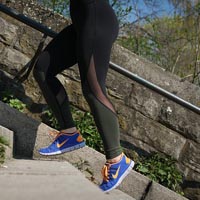Body fat and aerobic capacity of physical education students from a Chilean university

Accepted: 12 September 2021
HTML: 4
All claims expressed in this article are solely those of the authors and do not necessarily represent those of their affiliated organizations, or those of the publisher, the editors and the reviewers. Any product that may be evaluated in this article or claim that may be made by its manufacturer is not guaranteed or endorsed by the publisher.
The components of physical fitness, aerobic capacity and anthropometric characteristics play an important role in maintaining and protecting cardiorespiratory functioning during all stages of life. The purpose of this study was to analyze the relationship between body fat indicators and aerobic capacity of students in a physical education program. A descriptive study (cross-sectional) was carried out with 110 physical education university students (75 males and 35 females). Ages ranged between 17.7 and 26.1 years old. Weight, standing height, sitting height, waist circumference (WC), and seven skinfolds (mm) were evaluated. Body Mass Index (BMI) was calculated. The Navette test (20m back and forth run) was used to assess the students. The correlations between adiposity and aerobic capacity for males varied from r= -0.21 to 0.34 and for females, from r= -0.21 to 0.34. In general, greater body adiposity (BMI, WC, and skinfolds) was a determinant in the males (R2= 14 to 27%). For the females, the Σ 7 skinfolds explained 11% of the adiposity. Males and females classified as having a high level of aerobic capacity showed less fat tissue (Σ 7 skinfolds) than those with moderate and low aerobic capacity (p<0.05). The results from this study indicated that body adiposity expressed as fat tissue limited aerobic capacity in a greater proportion of the males than in the females. The youth classified with high aerobic capacity showed less body fat than their counterparts classified as having moderate and low levels of aerobic capacity.
Moreno GM. Definición y clasificación de la obesidad. Revista Médica Clínica Las Condes. 2012; 23(2): 124-128. DOI: https://doi.org/10.1016/S0716-8640(12)70288-2
Organización Mundial de la Salud. Obesidad y sobrepeso. Recuperado 15 julio, 2018. http://www.who.int/es/news-room/fact-sheets/detail/obesity-and-overweight.
Contreras Mellado V, Vilchez Avaca C, Gómez-Campos R, Luarte Rocha C, Cossio-Bolaños M. Tendencias al incremento de la adiposidad corporal y la presión arterial dejóvenes universitarios en dos cohortes (2009-2014). Nutr Hosp. 2015; 32(6): 2551-2558.
Ortega FB, Ruiz JR, Castillo MJ, Sjöström M. Physical fitness in childhood and adolescence: a powerful marker of health. Int J Obes (Lond). 2008; 32:1-11. DOI: https://doi.org/10.1038/sj.ijo.0803774
Moliner-Urdiales D, Ortega F, Vicente-Rodriguez G, Rey-Lopez JP, Gracia-Marco L, Widhalm K, Sjöström M, Moreno LA, Castillo MJ, Ruiz JR. Association of physical activity with muscular strength and fat-free mass in adolescents: the HELENA study. Eur J Appl Physiol. 2010; 109: 1119e1127. DOI: https://doi.org/10.1007/s00421-010-1457-z
Gu X, Chang M, Solmon M. Physical activity, physicalfitness, and health-relatedquality of life in school-aged children. J Teach Phys Educ. 2016; 35:117e126. DOI: https://doi.org/10.1123/jtpe.2015-0110
Lema L, Mantilla SC, Arango CM. Asociación entre condición física y adiposidad en escolares de montería, Colombia. Revista Internacional de Medicina y Ciencias de la Actividad Física y del Deporte. 2016; 16(62): 277-296. DOI: https://doi.org/10.15366/rimcafd2016.62.007
Valero G, Zurita Ortega F, San Román Mata S, Pérez Cortés J, Puertas Molero P, Chacón Cuberos R. Análisis de la capacidad aeróbica como cualidad esencial de la condición física de los estudiantes: Una revisión sistemática. Retos. 2018; 34: 395-402.
Minasian V, Marandi SM, Kelishadi R, Abolhassani H. Correlation between Aerobic Fitness and Body Composition in Middle School Students. Int J Prev Med. 2014; 5(Suppl 2): S102-S107. Minasian V, Marandi SM, Kelishadi R, Abolhassani H. Correlation between Aerobic Fitness and Body Composition in Middle School Students. Int J Prev Med. 2014 Dec;5(Suppl 2):S102-7. DOI: https://doi.org/10.4103/2008-7802.157666
Kumar A, Kumar M. Effect of Body Composition and Aerobic Capacity on Blood Pressure in Young Indian Adult Males of Age Group 18-21 Years. International Journal of Science and Research (IJSR). 2015; 4 (10): 816-820.
Ross WD, Marfell-Jones M. Kinanthropometry. En: Physiological testing of the highperformance athlete. Champaign, Ill: Human Kinetic.1998; p.223-308.
Leger LA, Mercier D , Gadoury C , Lambert J. The multistage 20 metre shuttle run test for aerobic fitness. J Sports Sci 1988; 6: 93 - 101. DOI: https://doi.org/10.1080/02640418808729800
Razak M, Maizi I, Muhamad TA. Physical Activity, Aerobic Fitness and Body Composition among Students in Malaysia and Libya. Asian Social Science 2013; 9(16): 168-175. DOI: https://doi.org/10.5539/ass.v9n16p168
Hayes L, White M, Unwin N, Bhopal R, Fischbacher C, Harland J, Alberti KG. Patterns of physical activity and relationship with risk markers for cardiovascular disease and diabetes in Indian, Pakistani, Bangladeshi and European adults in a UK population. J Public Health Med. 2002 Sep;24(3):170-8. DOI: https://doi.org/10.1093/pubmed/24.3.170
Fischbacher C, Harland J, Alberti KG. Patterns of physical activity and relationship with risk markers for cardiovascular disease and diabetes in Indian, Pakistani, Bangladeshi and European adults in a UK population. J Public Health Med. 2002 Sep;24(3):170-8. DOI: https://doi.org/10.1093/pubmed/24.3.170
Petersen S, Byrne H, Cruz L. The Reality of Fitness for Pre-service Teachers: What Physical Education Majors "Know and Can Do". Kinesiology, Sport Studies and Physical Education Faculty Publications. 2003; 67. https://digitalcommons. rockport.edu/pes_facpub/67
De Miguel Calvo JM, Schweiger I, de las Mozas Majano O, Hernandez-Lopez J. Efecto del ejercicio físico en la productividad laboral y el bienestar. Revista de Psicología del Deporte. 2011; 20(2): 589-604.
Amani AR, Somchit MN, Konting MMB, Kok L-Y. Relationship between Body Fat Percent and Maximal Oxygen Uptake among Young Adults. Journal of American Science 2010; 6(4): 1-4.
Enríquez D, Marcos-Pardo P, Martínez-Rodríguez A, Candia-Luján R, Carrasco Legleu C. Actividad física, ingesta alimentaria e indicadores antropométricos en estudiantes universitarios. Tecnociencia chihuahua. 2017; 11(2):58-68.
PAGEPress has chosen to apply the Creative Commons Attribution NonCommercial 4.0 International License (CC BY-NC 4.0) to all manuscripts to be published.


 https://doi.org/10.4081/ejtm.2021.10031
https://doi.org/10.4081/ejtm.2021.10031



